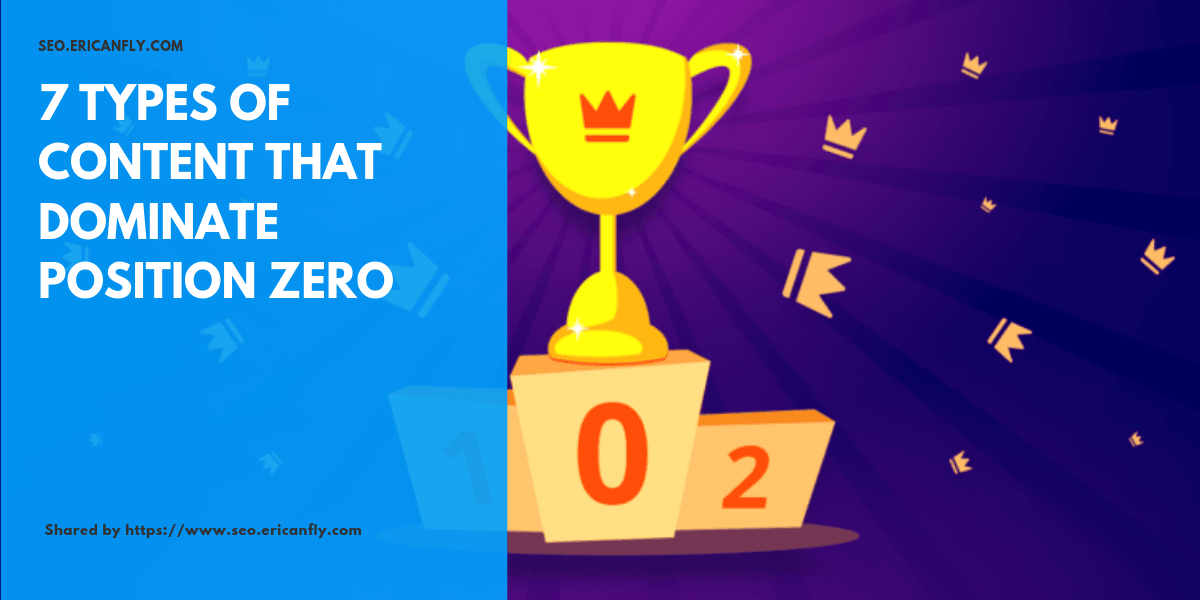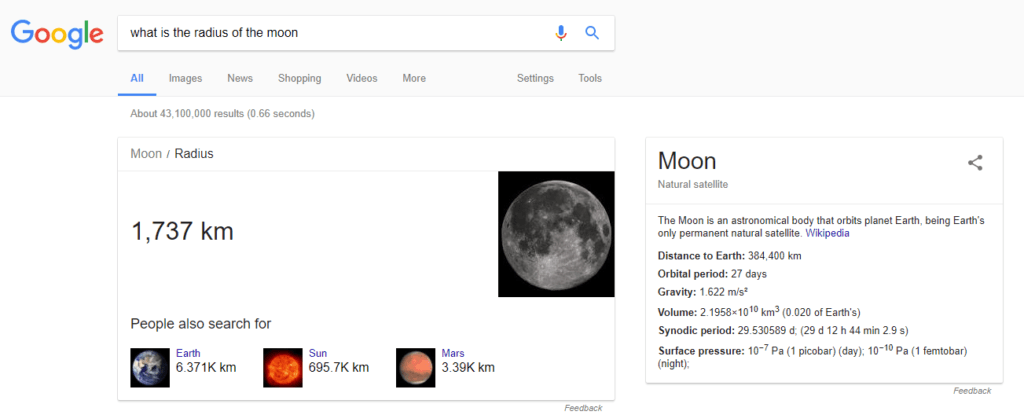
30 Aug 7 Types of Content That Dominate Position Zero
Since Google introduced featured snippets in 2014, they’ve become one of the holy grails of SEO.
Featured snippets are succinct answers to user queries displayed at the top of Google’s search results, occupying the coveted “position zero” in SERPs.
Unlike quick answers and knowledge panels, featured snippets use third-party information to answer queries and include the source page’s title and URL.
Featured snippets come in all shapes and sizes, including:
- Paragraphs
- Numbered lists
- Bulleted lists
- Tables
- YouTube videos
- Images
- Charts
The potential benefits of landing a featured snippet are huge:
- More traffic.
- Greater SERP visibility.
- A healthy boost to your credibility.
Voice search also leans heavily on featured snippets to answer user queries.
Also, because featured snippets aren’t necessarily plucked from the top result, you can sometimes edge out competitors on vital keywords.
Why fight over Position 1 when you can snipe Position 0?
Unfortunately, occupying position zero is easier said than done.
Featured snippets are volatile – a search that yields one featured snippet will show something entirely different an hour later. And we’re still piecing together exactly why some snippets are selected over others.
What we do know is that your content matters.
The brevity, formatting, and – most importantly – subject matter of your content all factor into whether Google considers your website snippet-worthy.
This article will walk you through the seven most “snippable” types of content you can create.
1. Answers to 5 Ws (Who, What, When, Where, Why)
The most common function of a featured snippet is to answer one of the Five Ws (who, what, when, where, or why) of intermediate difficulty.
The complexity of the question is key.
If Google considers the answer part of the public domain, they’ll supply a rich answer from their database.

If the question is too complex to unpack, Google will skip straight to their results.

And if the question is just right, then you might see an answer like this:

Who, what, where, why, and when questions about simple facts in your niche are some of the easiest and most frequently searched for topics.
Just make sure your subject matter is both:
- Simple enough that you can define it in a short paragraph or a list.
- Complex enough that it warrants a whole page to unpack.
The best way to discover new topics is to plug your keywords into rank tracking software.
Type out each of the Five Ws and fill in the tool with wildcards related to your niche. You should generate tons of suggestions related to your keyword.
If you’re struggling to come up with alternative creative ideas, look at Google’s “People also ask” feature for related topics.
When optimizing for long-tail keywords, keep in mind that the average length of a snippable keyword phrase is about six words.

2. How-tos/Instructions
Only 12.29 percent of search queries have featured snippets in their search results.
The lion’s share of those belong to instructions, recipes, and answers to how-to questions.
Instructional content is especially powerful because it encourages click-throughs and more time on page. Plus, users get more out of content that offers to teach them something.
Another benefit of how-tos are their less restrictive formatting.
Depending on the question, you can use text, lists, images, and even videos to instruct your users.

The downside of creating content around what, who, and when questions is that they’re often easily answered in a line or two.
Users who search for answers to these questions might be satisfied by the snippet and feel disinclined to click the link, diminishing your CTR.
How and why questions, on the other hand, easily lend themselves to robust answers.
Featured snippets function like teasers for your answers and encourage users to learn more by clicking the link.

3. Definitions (For Complex Terms)
Another type of question that makes for excellent snippable content: implied questions.
Voice search users will often ask full sentences, but mobile and desktop users are more likely to search for single words and stilted phrases.
Even though these queries aren’t phrased like questions, they imply questions.
For example, someone searching for “CTR” is presumably asking “what is CTR.”

If you can supply a thorough definition to this question, you’ll have great material for a new landing page.
However, Google also recognizes these types of queries as implied questions and often supplies dictionary entries to answer simple terms. You’ll need to focus on slightly more complex queries, such as “CTR,” if you want to score a featured snippet.
But don’t stop there!
Imbue your page with as much related, useful information as you can. If you start writing a page about CTR expand upon your definition with a how-to guide for measuring CTR and best practice strategies for improving your CTR.
Make your resource and rich and detailed as possible – improving your engagement rates might play a role in the selection of featured snippets.
4. Comparisons
Lists, tables, and text that compare and contrast two or more items make for great, snippable content.
Finding topics to compare is easy, whether you’re breaking down the pros and cons of link building tools, researching the differences between different dog breeds, or considering which phone to buy.

Formatting this type of content is often easier too since it easily lends itself to table format.
Simply mark up your page using the <table> tag, and don’t be afraid to include as much relevant information as you can.
If your page lands in position zero, Google will take this data and create a simplified version of your table for their featured snippet.

5. Price/Cost Breakdowns
Your users — and Google, by extension — love seeing price breakdowns.
Cost breakdowns are also great for scoring featured snippets.
A good way to use this content is to help your users compare and contrast the cost and features of your goods and services versus your competitors.
You may not be the cheapest option, but that might not matter if you bring more benefits to the table.

When price lists are prone to wild fluctuations or vary from place-to-place, price lists might not be an option.
Instead, consider creating estimate tables that will help your users budget for big-ticket items in your niche.
Any information that informs your users and makes their lives easier is good.

6. ‘Best’ Lists
One of the most frequently used word in search queries with featured snippets is the word “best.”
People always want to know what the “best” is – whether it’s the “best link building methods,” “best cell phone,” or “best restaurant near me.

”Don’t let your competition be the first and last word on what’s the “best” in your niche.
Create lists of best-in-class products and walk your users through why some products, businesses, strategies, etc., outperform others.
7. Frequently Asked Questions
To be clear, I am not talking about a FAQ page, which usually features sparse bits of information to a wide variety of subjects.
Content created around customer questions should be rich enough that you can dive into your subject and arrive at a detailed, nuanced answer.

If your page’s content updates regularly (e.g., vegan options on seasonal menus), include a “last updated” tag that tells Google and your users how current your content is.
How to Optimize Content for Featured Snippets
Now that you know what types of content Google favors for featured snippets, all you have to do is learn how to structure your content. The basic formula for how to rank in position zero is:
- Kick-off your content with a direct, simple answer to the question.
- Add more details and supporting information, including videos and images.
- End with supporting background information, such as examples and case studies.
Before you can store a featured snippet, you need to follow SEO best-practices:
- Optimize your site for desktop and mobile.
- Create a treasure trove of informative content.
- Do what you can to stoke your engagement metrics.
All of these factor into getting a featured snippet.
And, if you’re still having trouble, pay attention to snippets that already exist in your niche. Learn from your competitors and see which formats they favor, what advice they offer, and where you could improve to land your site in position zero.
Sources
https://www.searchenginejournal.com/content-types-position-zero/232453/#close

